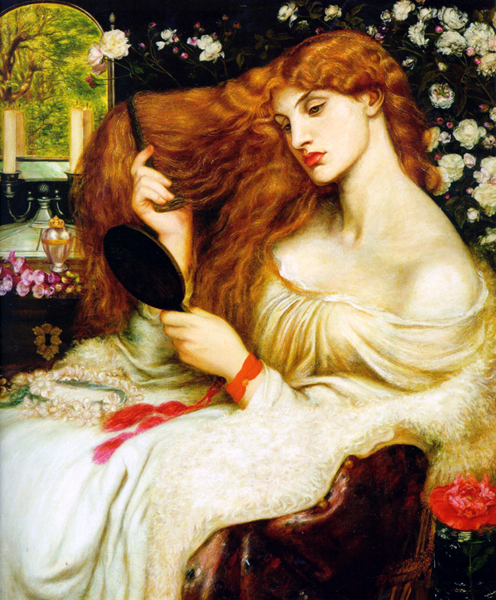I’ve mentioned my love of mirror paintings before: Circe Offering the Cup to Odysseus, Viola, Photograph of Fanny Cornforth, Seeking out mirrors, and Preparing for the Ball.

It’s understandable if we fail to notice the mirror in Dante Gabriel Rossetti’s Lady Lilith (previous post about the painting here). Our eyes are naturally drawn to Lilith, resplendent in billowing, uncorseted white. Languid. Sensual. She represents dangerous beauty: Of Adam’s first wife, Lilith, it is told/(The witch he loved before the gift of Eve,)/That, ere the snake’s, her sweet tongue could deceive,/And her enchanted hair was the first gold./And still she sits, young while the earth is old,/And, subtly of herself contemplative,/Draws men to watch the bright web she can weave,/Till heart and body and life are in its hold. –Excerpt from Rossetti’s sonnet on Lilith.
In the corner of the painting, we see a mirror. Neither ostentatious or large, it is a simple mirror that we might find in any room. But is it simple? We can see the reflection of the two candles that sit in front of it, but where is the rest of the room? Instead, we have an impossible reflection that could never truly exist. Due to some enchantment, this charmed mirror of Lilith’s reflects a bower, the Garden of Eden. The place of heavenly growth and abundance that will forever be denied to Lilith because she would not be submissive.
And does Lilith look at this mirror? No. She has provided a mirror of her own and contemplates her own features.


There was a lot of talk about mirrors at the ‘Pre-Raphaelitism, Past, Present & Future’ conference in Oxford. Both Isobel Armstrong’s plenary lecture and Claire Yearwood’s paper ‘The Arnolfini Doppelgänger’ (great title) were on the subject. It was a good weekend. I was sorry there weren’t more of the Pre-Raphaelite bloggers and Wombat Friday crowd there, though. Madeleine Pearce’s paper on digital curation would have interested you.
Hi Stephanie.
My initial interpretation of the image was that the “mirror” in the corner is actually a window. The glass of the time (1840-50s) would have been quite thick and definitely capable of reflecting the candle to the extent that it has been painted doing.
I do like the idea of it being a mirror, it adds an interesting depth to the painting.
Artists just love their ambiguity don’t they…